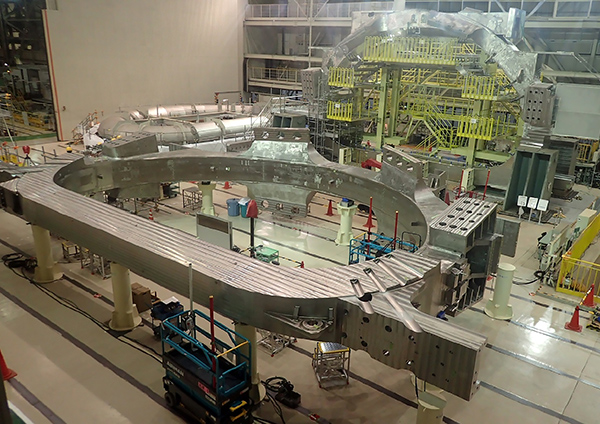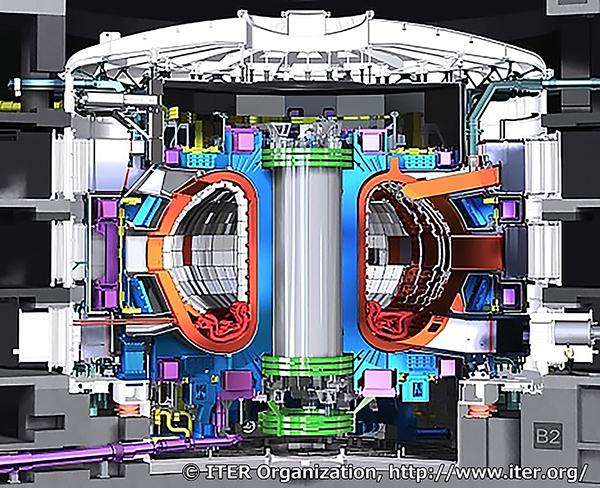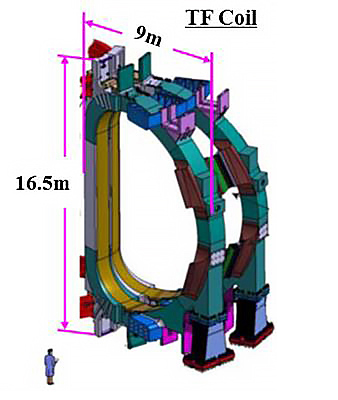Press Information
Ceremony Held to Mark Completion of First Toroidal Field Coil for ITER (Experimental Fusion Reactor)
-- World's Largest Superconducting Coil Signifies Major Progress in Fusion Reactor's Construction --
-- World's Largest Superconducting Coil Signifies Major Progress in Fusion Reactor's Construction --
Key Points:
・ Completion of the world's largest superconducting coil ever built
・ Director-General Bigot of the ITER Organization expressed his sincere gratitude and commended the manufacturing prowess
・ Established technology and techniques for welding large cryogenic stainless steel structures (approx. 230mm in thickness), enabling enormous superconducting coils (16.5m high, 9m wide, gross weight 300t) to be manufactured having a level of precision within 0.01%
The Fusion Energy Directorate of the National Institutes for Quantum and Radiological Science and Technology (QST) and Mitsubishi Heavy Industries, Ltd. (MHI), have completed manufacture of the first toroidal field (TF) coil for the ITER (experimental fusion reactor)-the world's largest superconducting coil ever built. To mark its completion, a formal ceremony was held at MHI's Futami Plant in Hyogo Prefecture, Japan. Among the attendees were QST President HIRANO Toshio and, representing MHI, President and CEO IZUMISAWA Seiji and Senior Vice President KATO Akihiko, who serves as Senior General Manager of the Power Systems' Nuclear Energy Systems Division. Honored guests included Director-General of the ITER Organization, Bernard Bigot, Parliamentary Vice-Minister of Education, Culture, Sports, Science and Technology, AOYAMA Shuhei, members of the Japanese Diet, representatives of related economic organizations, and various experts in their respective fields.

The newly completed TF coil is the first main structural component for ITER's magnet system, and its completion is a major milestone forward for the reactor's construction. Plans call for five TF coils to be produced at the Futami Plant, which will be shipped from Kobe Port to southern France in the run-up to the start of ITER operations in 2025. Completion of the first TF coil will give Japan-through a joint industrial, academic, and governmental effort-an even greater leading role in the ITER Project, which is pursuing technologies of the utmost importance for sustainable global development.
<Reference Materials>
Project Background

The ITER Project is an international megaproject aimed at demonstrating, both scientifically and technologically, the realization of fusion energy(Note). Seven Parties are participating: Japan, the EU, the U.S., Russia, Korea, China, and India. Construction of ITER is underway in Saint-Paul-lez-Durance, France, with a target operational startup date of 2025. Japan is playing a major role in developing and manufacturing the crucial components of ITER, including the TF coils. QST is in charge of procuring these components as the ITER Japan domestic agency for the ITER Project designated by Japanese Government.
ITER's superconducting TF coils are D-shaped and approximately 16.5m in height, 9m wide, and weigh some 300 tonnes. Eighteen TF coils will encompass the vacuum vessel container and generate a powerful magnetic field (maximum of 12 tesla) to confine high-temperature, high-density plasma within the vessel. The ITER Project requires a total of 19 TF coils (including one spare) to be made: 9 in Japan (including the spare) and 10 in Europe. The inner coil structures for all 19 TF coils will be manufactured at MHI's Futami Plant. Mitsubishi Electric Corporation is in charge of producing the Nb3Sn superconducting winding packs for five TF coils (including the newly completed coil), with the outer coil structures being manufactured in Korea, and final assembly performed back at MHI's Futami Plant.
Significance of Latest Achievement

To confine plasma inside ITER, a highly precise, strong magnetic field (12 tesla) is required, which called for the development of unprecedentedly large superconducting coils that use niobium-tin conductors. To maintain superconductivity, the coils must be able to function in cryogenic temperatures of -269 °C, which required special stainless steel structural materials capable of withstanding such low temperatures to be developed along with all requisite manufacturing technology. Not only was there no precedent for coils of this unsurpassed scale, the dimensional tolerances of the windings and coils required a high precision of within 0.01%.
QST commenced R&D for the TF coil manufacturing technology in 2005, and MHI began their manufacture in 2012. Working in collaboration, QST and MHI developed high-precision technology for winding niobium-tin conductors, and also developed durable structural materials made from a special stainless steel capable of withstanding cryogenic temperatures. Furthermore, to determine the conditions to suppress deformations caused by welding, parameter tests were conducted and the welds were verified using both miniature and full-scale specimens, which formed the basis for the fundamental technologies suited to the material's properties, including advanced welding procedures and machining techniques. In the end we were able to meet the stringent requirements demanded for ITER.
Future Schedule
Plans call for a total of five TF coils to be shipped from the Futami Plant in the run-up to the start of ITER operations in 2025. Completion of the first TF coil will give Japan-through a joint industrial, academic, and governmental effort-an even greater leading role in the ITER Project, which is pursuing technologies of extreme importance for sustainable global development.
- Fusion is the energy source that enables the sun to keep shining. The ultimate goal is achieving fusion here on Earth. Fusion reactions fuse light atomic nuclei-deuterium and tritium-in a plasma environment into a heavier element, helium. Fusion reactions emit zero carbon dioxide, and their source of fuel can be extracted from seawater in virtually unlimited quantities (lithium from which tritium is derived, and deuterium). Fusion energy is expected to provide fundamental solutions to many of the world's energy and environmental problems.
About MHI Group
Mitsubishi Heavy Industries (MHI) Group is one of the world’s leading industrial groups, spanning energy, smart infrastructure, industrial machinery, aerospace and defense. MHI Group combines cutting-edge technology with deep experience to deliver innovative, integrated solutions that help to realize a carbon neutral world, improve the quality of life and ensure a safer world. For more information, please visit www.mhi.com or follow our insights and stories on spectra.mhi.com.






